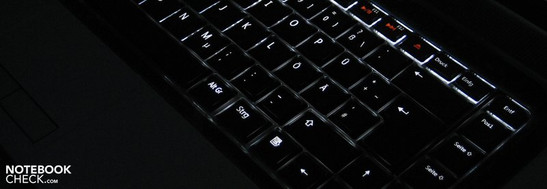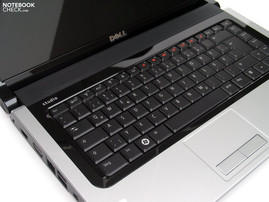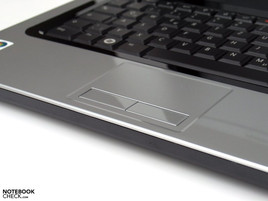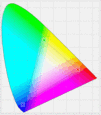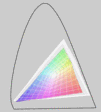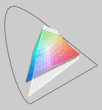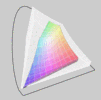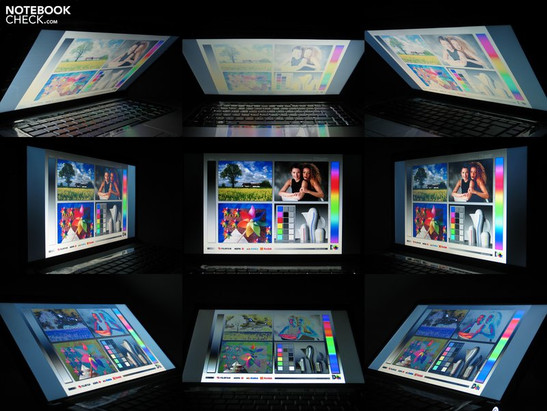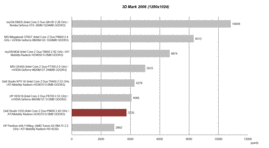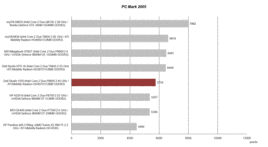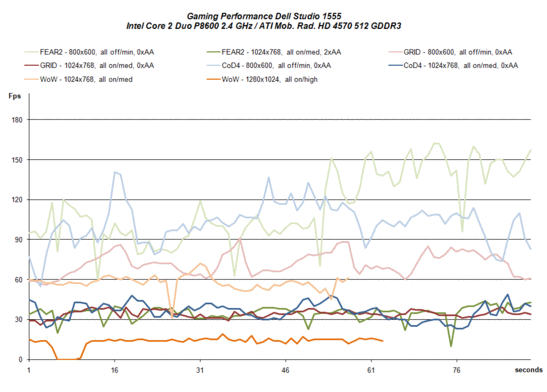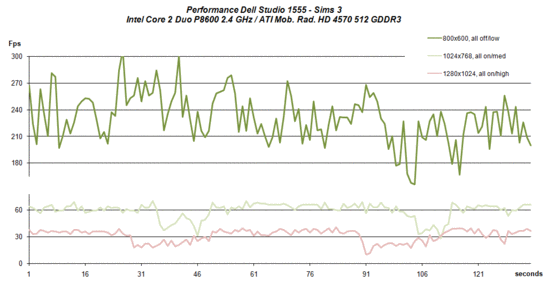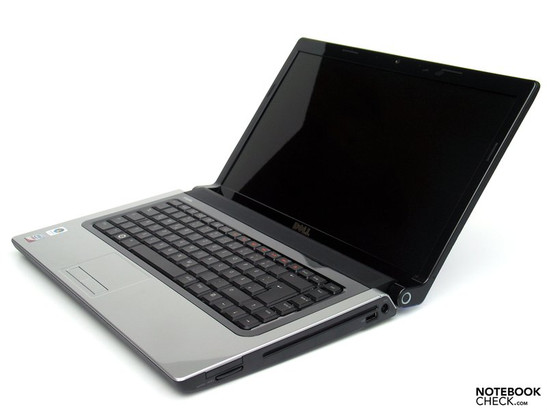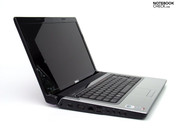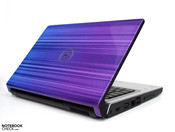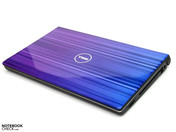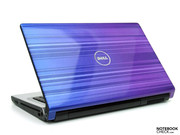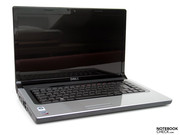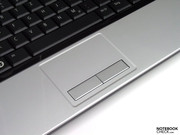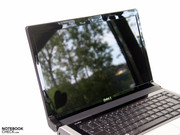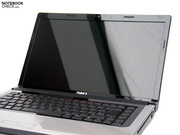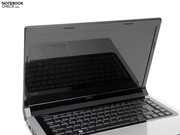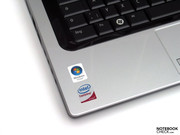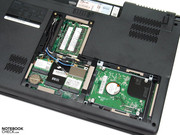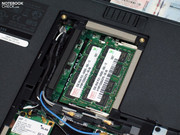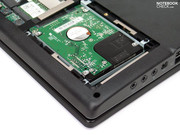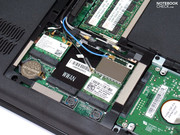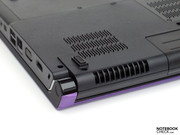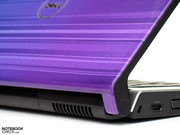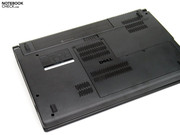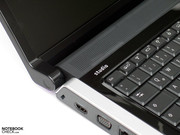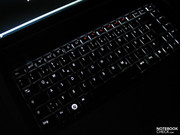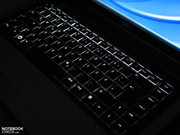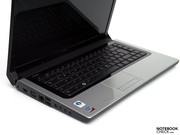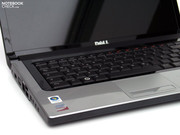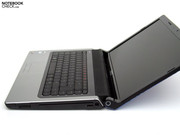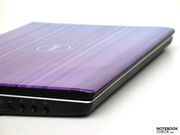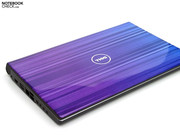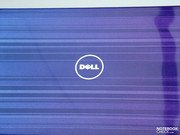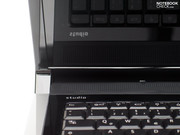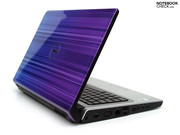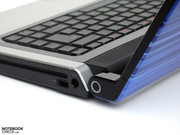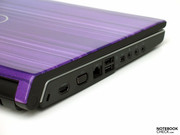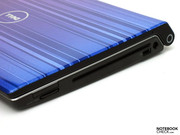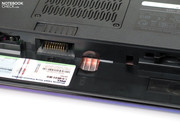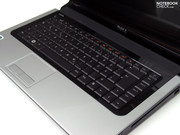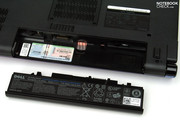Review Dell Studio 1555 Notebook
Media Artist.
Dell offers the new Studio 1555 models at a competitive price of 499.00 Euros and also promotes these accordingly. For this seeming bargain price you get a rather meager equipped basic version, though. But if you configure it well-considered, you still can achieve an attractive price for value ratio. Where the strengths, or rather the weaknesses of the low-priced multimedia starter are found should be uncovered in this comprehensive test.
The forerunners of the current version were also blessed with the label Studio 15. However, you can differentiate these through the last two digits of the model's number (1525, 1535 - 1555). Then what has changed in the latest edition of this multimedia notebook?
Following the current trend, Dell has now given the Studio 15 a display in a 16:9 cinematic format. The single components of the optional hardware have also been fitted to the state-of-the-art technique. Dell has recently started to look at its consumer notebooks more intensely as "lifestyle objects", and offers for example, the latest Studio15, in 17 different designs. The decision about the selection of hardware components should then be the least of problems...
Case
Maybe you can still recall the plain, wedge-shape design of past Studio notebooks. Those who couldn't accustom to that will then have bad luck because the current Studio 15 series also shows this line management. Dell will probably once again suit the taste of the majority, who reject high-gloss bolides as well as dull office cases, with the deliberate plain design, anyhow.
A bit of everything - that was probably the motto of the designer in charge. Whilst the base unit radiates more of a business charm with its matt-black case shell, it gets clearly more consumer-orientated with the lighted keyboard over the glossy, black finished display bezel up to the colorful display lid.
The numerous cover designs of the lid deserve a special mention. Aside from the six different unicolored finishes, there are also many artistically created designs offered. There should be something among these for every taste, merely the wallet will snarl somewhat: Up to 89.00 Euros surcharge are to be shelled out for the ornate display covers - Respect!
In regards to the applied materials, Dell still sets on plastic, which has an effect on the notebook haptics. It repeatedly came to quiet groaning noises when handling the device, under which the quality impression of the notebook does suffer somewhat, in the end. Aside from this, a slightly too sharp plastic edge on the notebook's front side on our test sample has to be criticized, but this doesn't restrict the laptop's use.
Despite this, the base unit's stability turns out to be sufficient. There's neither an extensive deformation to be observed at compressive load nor at picking up the chassis.
It looks a bit different with the display, though. This can neither convince in regards to pressure stability (especially in the area of the Dell logo on the display frame) nor in respect to torsional stiffness. The same applies to the folding mechanism. The hinges have been made to look very large and seemingly sturdy, but can't prevent a flapping of the display, though. The noises at opening and closing the display doesn't exactly testify the most stable construction method, either.
The omitting of a security latch, which fixes the display in a closed transportation state, can be coped with. But you should take care at stowing the notebook. The elaborate (and expensive) display covers would have deserved their own, softly cushioned protection cover, anyway. No problem, as Dell also has a fittingly designed backpack in their program - although for an additional 48.99 Euros (Energy Collection).
Connectivity
Loyalty to the principal of connection arrangement on the notebook's side edges has also been generally kept upright in the Studio 15. The battery finds its place on the back side, and the display hinge also obstructs a placement of additional ports in this area.
It quickly becomes obvious that the connections are positioned especially favorable for righties, as the majority of these have been placed on the left side edge. A drive with a "slot-in" mechanism, as well as a 34mm Expresscard slot and a cardreader have been positioned on the right side. In the back area of this side there is also an USB port and the connection for the power supply of the device, too.
Lefties (approx. 10 - 15% of the population according to studies) will only be partly delighted about the connectivity on the left side edge. It has obviously been attempted to put intervening and often permanently occupied ports more into the back area. For example, the HDMI port, VGA-out and the LAN interface would count to these. A further USB port and a combined USB/eSATA socket are found in the middle section placed one below the other. A Firewire and the audio ports (2x headphones, microphone) follow this.
The whole range of communication features is also available for the new Dell Studio 15, many of these only for an according surcharge, though. A fast gigabit LAN from Broadcom and a wireless LAN module from Dell (1397 – 802.11 b/g) is implemented ex-factory, in any case. And so is a standard-n supporting wireless module from Dell. Both of the proven Intel mini-cards WiFi Link 5100 and 5300 (a/g/n) would also be possible as an alternative.
If a wireless linking of the Studio 15 with various peripheral devices is being considered, then the configuration with an integrated Bluetooth module might make sense, so that all existent USB ports can be kept vacant. This option costs 34.99 Euros.
The optionally available mobile broadband option might be of interest for many potential buyers, in view of the numerous luring offers of mobile providers. For the according mini-card, including antennas and cables, an additional 120.00 Euros have to be paid.
To be listed as a further configuration feature is also (without surcharge) the integrated 2 megapixel webcam. Pictures with a resolution of up to 1600x1200 pixels or video recordings with up to 640x480 pixels are possible with it. The cam delivers a good and smooth image even at maximum resolution. The sensor's good light sensibility, which also provides a good image at low surrounding light, makes a positive impression. The depth of field also turned out surprisingly good. Useable image quality for video chats is achievable from 20 centimeters up to over a meter.
Dell naturally has an optional configuration with the according hardware for BluRay fans in the program. An integrated player is attainable at a surcharge of 140.00 Euros, while the player/recorder combination still adds up to a proud 369.99 Euros. The DVD burner is built-in ex-factory without surcharge, though.
Let's finally come to the possible warranty options. If you orientate yourself on the current basic offers, then the Studio 15 comes with a basic warranty of one year. The device can be upgraded in several steps up to an overall maximum of 4 years on-site service. Currently 209.00 are due for this. From experience, Dell makes special campaigns time and again, particularly in view of warranty, where an upgrade is attainable for often considerably less or even without surcharge. It could prove to be worthwhile to keep an eye on the prices for a time.
Input Devices
The keyboard's most striking feature is probably its lighting (optionally obtainable, surcharge 40.46 in Germany, only available by telephone). Different than external light sources, this has the advantage that all keys remain readable with a good contrast and no unpleasant reflections turn up even in complete darkness. In order to make the best individual accommodation possible, brightness can be chosen between two stages, or be deactivated completely, with the according key.
The layout of the implemented keyboard is classical and without noticeable deviations. You can also take delight in the normal key size of the arrow keys. Altogether the keyboard appears very generous and makes an accurate typing possible right from the start. The typing feel can be described as being rather soft, but nonetheless with a very distinctive pressure point and a slight rebounding in the end. This is mainly because the keyboard does obviously inflect partially under pressure. Surprisingly, the soundscape didn't suffer due to this at typing.
The touchpad optically integrates itself seamlessly into the case. However, the surface has been roughened slightly in order to enhance the gliding properties, which has been executed very successfully. Both keys let themselves be pressed without much resistance and show a comparably deep stroke length. However, we have to criticize the keys' implementation fairly deep in the case, through which a tipping with the thumb isn't always possible.
The preferences of the additional function of the F-keys turn out interesting and very helpful. Instead of the rarely used F1 to F12 occupation, Dell pulls functions such as display brightness, volume, multimedia,... into the foreground of the Studio 15 and makes these to primary commands - greetings from Apple.
Display
As already mentioned, the 15.6 inch LED display in 16:9 format is one of the more significant innovations of the current Studio 1555 series. Dell follows, like almost all other manufacturers, the latest trend of orientating themselves on standard movie formats. As already often explained, this is quite helpful at rendering BluRays and DVDs, as the black bar usually turns out significantly thinner and therefore the real image is larger than on the 16:10 screens, but you have the disadvantage of a lower image height available for the common PC applications. This means only the upper part of a website or an application is seen and this leads to an increased need of scrolling.
This critique point naturally only applies to the WXGA screen with a resolution of 1366x768 pixels. A sufficient overview for all applications should be provided for in the alternately available Full-HD version (1920x1080 pixels), in any case. We were positively surprised from the comparatively low-priced Full-HD surcharge option: For merely an additional 60.00 Euros you can enjoy native Full-HD images.
The lower resolutive screen was also found in our test sample. The screen (SEC5441) reached a display brightness a maximum brightness of a good 213 cd/m2 in the test. The LED screen can also score with an above average good illumination of 88.7%. A good average is the maximum reached contrast ratio of up to 180:1, too.
| |||||||||||||||||||||||||
Brightness Distribution: 89 %
Contrast: 181:1 (Black: 1.18 cd/m²)
Possible hopes of an especially high-quality screen had to, at least in the standard WXGA display, be abandoned in regards to color representation. Our measurements with support from the Spyder 3 colorimeter from Datacolor show a color space which is considerably smaller than the common RGB color space, for example. In analysis of the color space diagrams, an outliner in the blue color area becomes obvious. Hence, the display is to generally be rowed into the league of the standard screens, in regards to color representation. In comparison, the extremely large color space of the Studio XPS 16 from Dell , equipped with the RGB LED display, becomes especially impressively obvious, but equipped with the RGB LED display.
However, due to the low surcharge of the alternate Studio 15 Full-HD version, you shouldn't await a large improvement in regards to color representation in this display. According to various unverified internet information, several displays from different manufactures are used in the Studio 1555, which partly differ considerably from each other.
It doesn't matter which display is chosen, there is no way around the TrueLife surface. TrueLife is Dell's name for a glossy display. The test for the display's outdoor suitability was, as expected, rather disappointing. The given brightness would still be adequate to provide a sufficient image contrast at least in the shade, but the reflections which turn up make working with the device very arduous.
The given viewing angle stability definitely doesn't belong to the display's strengths. Already the slightest deviation from the ideal, that is to say the perpendicular viewing angle, color changes and also an increase of reflections can be observed. This applies especially to the vertical viewing area, whilst along the horizontal axis you struggle more with reflections than with color changes.
Performance
Depending on the individual requirements, the Dell Studio 1555 can be equipped with various hardware components, for instance the CPU. Dell implements a T4200 Dual Core CPU from Intel in the starter package. With 2.0 GHz, 1 MB L2 cache and 800 MHz frontsidebus. With this processor you are sufficiently equipped for basic applications, as the dual core CPU provides a fast advance at multitasking, too.
If more power is needed for special applications, for example audio or video editing, more efficient chips from Intel might be of interest. The currently strongest traceable CPU in German web shops is Intel's P8600, which represents a good compromise between performance, power consumption (TDP 25W) and price, with 2.4 GHz and 3MB L2 cache. At the moment, a surcharge of 180.00 Euros is taken for this chip (based on the T4200 basic version). According to the specifications, a configuration with the T9800 CPU should be possible, which count to the currently strongest available, mobile dual core processors with 2.9 GHz and a 6MB L2 cache.
The potential buyer also has the possibility of customization to individual needs in the graphic card. The basic configuration is defined through an integrated Intel GMA 4500M HD graphic chip, which is also conceived for basic applications. However, rendering HD videos should also be possible with the GMA 4500M HD. It first gets problematic, when you request 3D calculations. The integrated graphic chip gives up comparatively fast.
In particular computer game fans will then cast an eye on the alternately available ATI Mobility Radeon HD 4570, which is obtainable either with 256MB video memory (+100.00 Euros) or with 512MB (+155.00 Euros). According to Dell, the 256 version will be discontinued mid-term, because a price reduction of GDDR3 memory chips is to be counted with and therefore a differentiation doesn't make much sense.
The exaltation will be kept within limits with this graphic card. The HD 4570 is to be qualified as a representative amongst the lower middle class and plays in about the same league as a Geforce 9500M GS or the older 8600M GT.
The graphic card can also be equipped with normal DDR memory modules, but Dell sets on a higher quality GDDR3 (512MB) in our test device, which is slightly faster but also somewhat more expensive. The graphic card configuration with a 64 bit memory bus (confirmed by Dell and AMD), in opposition to reference of many tools such as also CPU-z, which use a 128 bit memory bus, is also interesting.
The result of the 3D Mark 2006 benchmark test turns out accordingly average. equipped with a Geforce 9600M GT graphic card, but with a slower GDDR2 memory. The GX400 from MSI, also configured with a Geforce 9600M GT, however with a GDDR3 memory is ahead here with almost 1000 points.
The notebooks scores somewhat better in the PCMark 2005 benchmark comparison. The Studio 1555 can reap in an acceptable result with 5754 points.
In the case of the Dell Studio 15 DDR2 memory module, the built-in RAM also has something to say on this issue. The maximum given configuration is 4 gigabytes, which Dell lists as a 2GB (2x1024MB) with a surcharge of 60.00 Euros.
The options for the system memory turn out somewhat more extensive. Dell offers models with a velocity of 5400 rpm as well as 7200 rpm. In the test, the faster hard disks present a higher transfer rate and slightly shorter access rates than the 5400 models, as a rule. The implemented disk in our test sample from Western Digital (WD 3200BEVT) with a gross capacity of 320 gigabyte at 5400 rpm shows good transfer rates of up to 69.8 MB/s and an equally attractive access time of 17 milliseconds.
| 3DMark 06 Standard Score | 3735 points | |
| 3DMark Vantage P Result | 1168 points | |
Help | ||
| PCMark 05 Standard | 5754 points | |
| PCMark Vantage Result | 3607 points | |
Help | ||
Gaming Performance
That the built-in ATI mobility Radeon HD 4570 doesn't exactly belong to the hottest potatoes which AMD /ATI has to offer is already shown by the first performance index in the 3D Mark 2006 benchmark test. But the performance in the practical gaming mode, which we looked at in following by means of a few test games, is interesting in the end.
FEAR 2, the latest sequel of the horror shooter FEAR, belongs to one of the benchmarked representatives. At minimum possible hardware demand (800x600, all off/min), sampling the demo allowed a monitoring of an absolutely smooth frame rate of usually more than 90 fps. Increasing the graphic details and the resolution (1024x768, all on/med), this decreases dramatically to around 30 fps. The game remains generally fairly playable at this level, but since short interruption have to be counted with, you should reduce the settings even more.
Also of interest, from experience, is the demanding race game Racedriver: GRID. An average frame rate of 60 - 90 fps could be reached at minimum system requirements, which allows for absolutely smooth gaming. The game also stays constant at a still acceptable level after increasing the demands (1024x768, all on/medium/0xAA) between 30 and 40 fps. Therewith, the game can be played even with an attractive graphic presentation.
Also a must is, of course, the classic shooter Call of Duty 4, which also ran absolutely smooth at minimum graphic settings without any problems on our test device. Higher graphic demands (1024x768, all on/med/0xAA) also suppress the result here to partly under 30 fps, which leads to occasional studders at gaming.
Last but not least, we also looked closer at the popular online-role play World of Warcraft. Fraps delivered around 60 fps at medium detail level and with that enough images to play absolutely smooth. It may even be possible to increase the one or other detail option. The performance first crashed to under an useable value at maximum details (1280x1024). An average of about 15 fps and partly longer interruptions aren't really suitable for playing.
Further games and their performance with a built-in ATI Mobility Radeon HD 4570 are found in our benchmark editorial of Computer Games on Laptop Graphic Cards.
Addendum: The latest sequel of the successful Sims row has also just reached our editorial office. The first benchmarks with Sims 3 have confirmed a sufficient performance of the Studio 1555, as well. The observed frame rate in minimum possible settings was over 200 fps and the game was smoothly playable.
However, the performance could notably be curbed at a medium detail level, which Fraps records at sampling with an average of about 60 fps. Periodically the frame rate decreased to fewer than 30 fps and shuddering became particularly noticeable when scrolling from a larger distance.
Explicitly high details and all effects activated are less advisable. At a resolution of 1280x1024 pixels (external monitor) the game still reached an average of around 30 fps but occasionally fell down to less than 10 fps, which were made obvious in annoying game interruptions.
Emissions
System Noise
Fortunately, the Dell Studio 1555 presents itself in office mode as a pleasantly quiet contemporary. Not demanding the device excessively and using it in the energy savings mode, which is sufficient for many applications such as mails, internet and word processing, you are awarded with an especially low soundscape. The fan usually remains completely deactivated in this state and merely the hard disk's running noise is to be heard with 30.3 dB(A).
The fan does become very audible under load. We could observe a maximum possible system noise of up to 44.6 dB(A) at a consequent CPU and GPU load over a longer period. However, the notebook's volume stayed slightly lower in gaming mode and can therefore still be called acceptable.
Noise level
| Idle |
| 30.3 / 30.3 / 35.4 dB(A) |
| HDD |
| 31.8 dB(A) |
| DVD |
| 36.9 / dB(A) |
| Load |
| 37.8 / 44.6 dB(A) |
 | ||
30 dB silent 40 dB(A) audible 50 dB(A) loud |
||
min: | ||
Temperature
The pleasant soundscape has its price, which is manifested by means of an eminently high temperature on the bottom side of the base unit. We could measure a maximum of 52.8°C here, which could be designated as being a bit too much for a compact multimedia notebook such as the Dell Studio 1555. The heating stays within a limit at low performance demand (approx 40°C), which should still allow a use on the thighs.
(+) The maximum temperature on the upper side is 39.4 °C / 103 F, compared to the average of 36.9 °C / 98 F, ranging from 21.1 to 71 °C for the class Multimedia.
(-) The bottom heats up to a maximum of 52.8 °C / 127 F, compared to the average of 39.2 °C / 103 F
(±) The palmrests and touchpad can get very hot to the touch with a maximum of 37.32 °C / 99.2 F.
(-) The average temperature of the palmrest area of similar devices was 28.7 °C / 83.7 F (-8.6 °C / -15.5 F).
Loudspeakers
We were very pleasantly surprised by the given sound at rendering music of the most various styles. The Studio 1555 delivers a clear and occasional full sound at a good maximum volume. The proportion between the trebles and the basses wasn't quite balanced, but more than expected for a multimedia starter notebook. A subwoofer placed on the bottom side is primarily responsible for the attractive soundscape, which provides the necessary sonority. The Dell Studio 1555 can't keep up with multimedia pros liked the Pavilion HDX range or Toshiba's Qosmio models , but you still have to find a comparable sound in the low-priced starter category.
Battery Life
The battery's basic variant is a 6 cell Li-Ion battery with a capacity of 56 Wh. There is also a 9 cell battery version alternately available, which has 85 Wh, but demands a surcharge of 70.00 Euros. A runtime increase of about 50% can be assumed with this solution in a similarly configured notebook.
Our test device reached a maximum possible runtime of 293 minutes, which is almost 5 hours, with the 6 cell battery in the BatteryEater Readers Test (min. display brightness, energy savings mode, WLAN off).
However, it looks completely different when the notebook is put under load. The Studio 1555 reached, in the tested configuration, merely 73 minutes in the BatteryEater Classic test (max. brightness, WLAN on, high-performance profile).
The deducted battery life in practical WLAN mode (max. display brightness, energy savings profile, WLAN on) turned out to be very well useable. The Studio 15 can also be used independently of the mains with 208 minutes, which is equivalent to about 3.5 hours. Our test device lasted for 148 minutes at DVD rendering, which should be adequate for a movie of average length. Caution is called for when playing BluRay contents in battery mode. The significantly higher computing demand causes an obvious shorter battery life, in which it is barely possible to render a complete track in battery mode.
| Off / Standby | |
| Idle | |
| Load |
|
Key:
min: | |
Verdict
The Studio 1555's case differs only slightly from those of its forerunners. The possibility of individualizing by the choice of 17 possible designs is particularly pleasant. Dell's surcharge politics turn out somewhat painful, though.
The case shows a few weaknesses in regards to stability, but can score very well with its looks.
Unfortunately, "merely" the HD screen with a resolution of 1366x768 pixels was built into our test device. Of course, the optional Full-HD display with 1920x1080 pixels would have been very exciting, especially in the configuration with the BluRay drive. The surcharge of 60.00 Euros should be worth the benefit of a finder resolution and more desktop overview, regardless of the precise measurement data.
The scoring of the Studio 1555 in the gaming tests was certainly of interest for many potential customers in Germany. Well, the notebook didn't have problems with most of the tracks at low detail, but a more attractive graphic on the display would have been ultimately desired, whereas the resources of the ATI 4570 graphic card are rather restricted. Naturally, you can hope for an upgrade in consideration of the GPU in the Studio, but in view of the doubtlessly upcoming refreshes in frame of the normal product cycle, where probably similarly positioned chips will find application, you shouldn't hope too much. After redesigning of the XPS series, Dell is obviously on the way of giving up the gaming branch completely to Alienware.
It's also been noticed, as it is common at Dell, that the advertised prices are quickly partially exceeded at an individual configuration. However, you have the possibility to add only what you really need in your personal package . At a higher configuration it's usually worthwhile to set on an according offer, as upgrading the starter variant is often more expensive.
The latest Studio 15 from Dell could be worth looking at for multimedia fans with a not so distinct gaming affinity.









